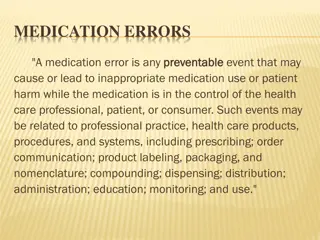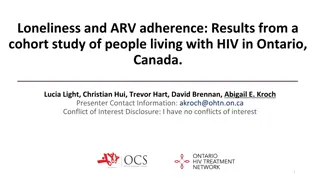Insights on Race and Medication Adherence in EoE Patients
This presentation discusses findings on the relationship between race and medication adherence among Black and Non-Black children with EoE. It highlights differences in symptom severity, access to care issues, and medication nonadherence in the Black patient cohort. The authors assessed adherence through chart reviews and utilized machine learning to study negative descriptors in EHRs. Additionally, the study looked at noncompliance Z-codes and their associations with social determinants of health in hospital settings.
Uploaded on Sep 17, 2024 | 2 Views
Download Presentation

Please find below an Image/Link to download the presentation.
The content on the website is provided AS IS for your information and personal use only. It may not be sold, licensed, or shared on other websites without obtaining consent from the author.If you encounter any issues during the download, it is possible that the publisher has removed the file from their server.
You are allowed to download the files provided on this website for personal or commercial use, subject to the condition that they are used lawfully. All files are the property of their respective owners.
The content on the website is provided AS IS for your information and personal use only. It may not be sold, licensed, or shared on other websites without obtaining consent from the author.
E N D
Presentation Transcript
CEGIR Diversity Presentation March 22, 2023 Pooja Mehta MD, MSCS
Methods Methods Selected Black children with EoE aged 1-17 years old seen in 2 urban clinics from 2010-2018 Age/sex matched Non-Black children with EoE during the same time period and retrospectively compared clinical features and outcomes
Authors conclusions Overall, there were some important differences between our two cohorts, suggesting black patients may present with more severe symptoms or have issues with access to care. Medication nonadherence was greater in our black cohort.
What is the relationship between What is the relationship between race and medication adherence? race and medication adherence?
How do we assess adherence in How do we assess adherence in EoE does race play a role? does race play a role? EoE and why and why It seems that the authors assessed adherence via chart review. Is this accurate?
Using machine learning, these researchers examined over 40,000 H&Ps/progress notes from over 18,000 patients Black patients had 2.54 times the adjusted odds of having one or more negative descriptors in the EHR compared with White patients Most common negative descriptors: refused, not-adherent, not- compliant, and agitated Patients with Medicaid (had higher adjusted odds (OR: 2.66) of a negative descriptor compared with patients with private or employer- based insurance
Looked at noncompliance Z-codes and compared them to social determinants of health over greater than 1,000 hospitals and nearly 9 million inpatient admissions
Other factors relevant to adherence Other factors relevant to adherence Many studies have found that patients from marginalized communities have greater negative beliefs regarding medications and less trust in medicine based on the complex interrelationship between social conditions and historical experiences. Patient-Physician interaction including negative effects of implicit bias and positive effects of race concordance of prescribing physician Higher rates of poverty experienced Black and Hispanic patients due to systematic inequalities over decades. 1. 2. 3. Shavers VL, Lynch CF, Burmeister L, Annals of Epidemiology, 2002 Shen MJ et al. J Tacial Ethn Health Disparities. 2018 McQuaid EL. Annals of Allergy, Asthma, & Immunology. 2018.
Where do we go from here? Where do we go from here? Take home point: when addressing medication adherence, its important to know that it is incredibly intertwined with other social determinants of health and disparities experienced by marginalized communities McQuaid EL. Annals of Allergy, Asthma, & Immunology. 2018.























